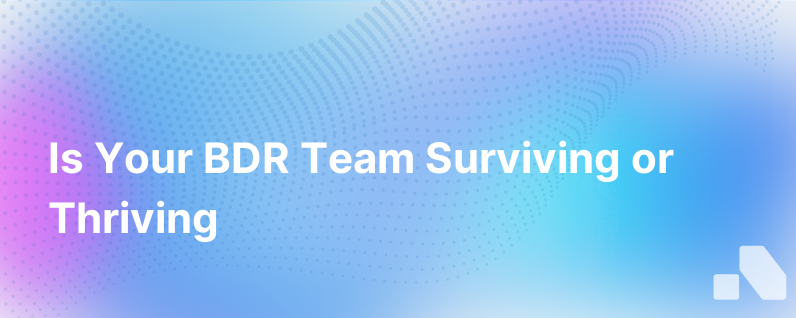Are Your Bdrs Surviving Or Thriving
Published on November 5, 2023 by David Zhang
In the ambitious arena of B2B sales, the role of a Business Development Representative (BDR) is often the linchpin in the machinery of a company's acquisition strategy. BDRs create the crucial first connection between potential customers and the value proposition of the company. The question that lingers for decision-makers and sales leaders, however, often hinges upon a simple dichotomy: Are your BDRs merely surviving, or are they truly thriving in their roles?
The answer requires a multifaceted exploration of your sales ecosystem—from support and training to technology and empowerment. Let’s dissect the indicators of success and distress within BDR teams and the strategic injections that can convert daily grinds into productive growth.
The Surviving BDR
A "surviving" BDR might meet the minimum expected outcomes, perhaps hitting modest sales targets or maintaining an average lead conversion rate. But does an average signify success? Here are signs that your BDRs are just surviving:
- High turnover rates: If BDRs are exiting the company alarmingly frequently, it’s a sign that your team might be struggling to keep up in a demanding atmosphere.
- Burnout and low morale: Long hours, high stress, and the never-ending chase for leads can take a toll. Survival mode kicks in when motivation dips, and job satisfaction becomes a distant consideration.
- Dependence on aggressive cold calling: When BDRs are heavily reliant on mass cold-calling tactics, it’s usually because they lack the deeper insights or tools needed to strategize their approach.
- Low engagement rates: If conversations with prospects are few or lack depth, it’s likely that BDRs are struggling to spark genuine interest or are chasing poorly qualified leads.
- Minimal growth opportunities: BDRs stuck with rudimentary tasks and no path for professional development will claw to stay afloat rather than contribute to expansive team achievements.
The Thriving BDR
Conversely, a thriving BDR team is characterized by:
- Low attrition: A stable, consistent team indicates that people find the work environment supportive and the role fulfilling.
- Passion and high energy: BDRs brimming with enthusiasm are likely experiencing success, recognition, and a sense of belonging within the team.
- Strategic lead generation: Thriving BDRs employ sniper-like precision in identifying and engaging with leads. They are backed by research, tools, and tailored engagement plans.
- High-quality conversations: Successful BDRs engage prospects in meaningful dialogue, understanding their needs, and positioning offerings as viable solutions.
- Continual learning environment: Access to ongoing training and clear advancement paths reflect a team that's not just operating but flourishing and growing.
What Discrepancy Between the Surviving and Thriving
So, what sets thriving sales environments apart from those merely surviving? It boils down to a few critical factors:
- Investment in sales enablement: Thriving BDRs rely on a robust framework of sales enablement tools that arm them with up-to-date market intelligence, thorough account insight, and agile content.
- Quality of training and onboarding: Excellence in performance is often preceded by excellence in training. Effective onboarding ensures BDRs are well-acquainted with the product and the best sales practices.
- Adopting a data-driven approach: Using data analytics to inform strategy allows BDRs to focus their efforts where they are most likely to succeed, thus improving output and morale.
- Empowerment via technology: Tools like Aomni infuse BDRs’ efforts with AI that can perform real-time account research, competitive analysis, and personalized content curation in minutes, effectively turning laborious tasks into manageable, automated processes.
- Cultivating a supportive culture: When sales teams feel backed by their leadership and peers, they're positioned to take calculated risks and innovate in their approach to prospecting and engaging leads.
The Role of Leaders in Transitioning from Survival to Success
Leadership is fundamental in guiding BDR teams across the divide from a survival state into a thriving culture. Here's what leaders can do:
- Prioritize wellness: Show commitment to work-life balance; it’s essential for sustainable performance. This includes acknowledging overwork and providing relief.
- Nurture skills and career pathing: BDRs should see a trajectory for growth; otherwise, their view narrows to the treadmill of daily quotas without any horizon.
- Foster collaboration: Encourage sharing of techniques and knowledge across the team. Mentoring and teamwork can elevate the collective strength of the sales force.
- Regular feedback mechanisms: Constructive feedback and recognition are not just morale boosters but pivotal checkpoints for continued improvement and engagement.
- Leverage advanced sales platforms: Adopting intuitive platforms like Aomni can streamline BDRs' efforts, alleviating the stress of manual research and enabling them to focus on what they do best—building relationships.
Conclusion
Your BDRs’ state—as either surviving or thriving—speaks volumes about the overall health of your sales operation. Challenges will arise, but the focus should remain steadfast on supporting a sales culture that's centered around empowerment, intelligence, and growth.
By emphasizing targeted training, adopting smart technologies, and fostering a culture of wellness and support, you can ensure that your BDR team not only survives but truly thrives. As a bonus, they'll become an unstoppable driving force for your company’s sales funnel, and perhaps, even more importantly, potent ambassadors for your organizational values.